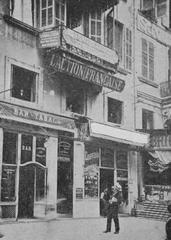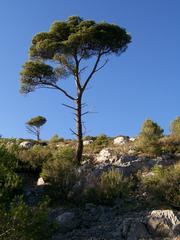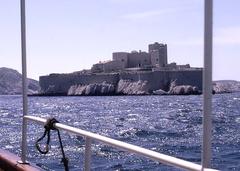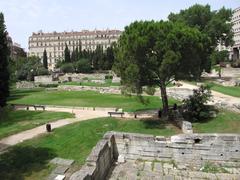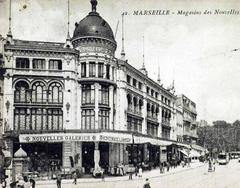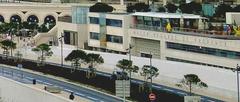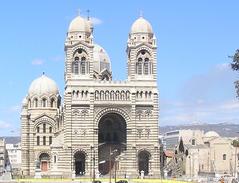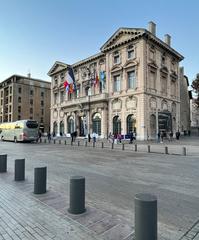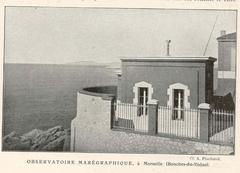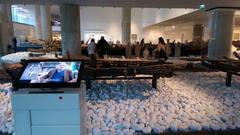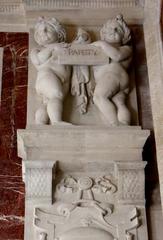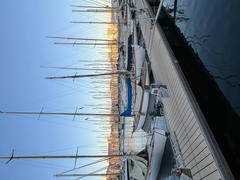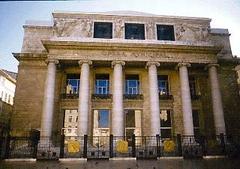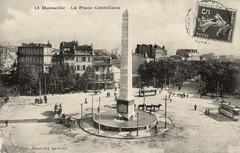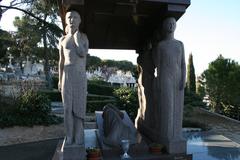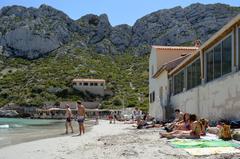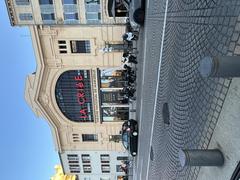Calanque des Figuières Visiting Guide: Tickets, Hours, and Tips
Date: 01/08/2024
Why Visit Calanque des Figuières?
Calanque des Figuières, nestled within the Calanques National Park in Marseille, France, presents a captivating blend of natural splendor and historical depth. Renowned for its striking limestone cliffs, azure waters, and diverse ecosystem, Calanque des Figuières is a testament to the region’s geological and cultural heritage (Calanques National Park). From its early agricultural uses to its role in World War II and subsequent transformation into a protected natural reserve, the calanque’s evolution reflects broader historical and environmental trends (Wikipedia). Whether you’re an avid hiker, a history enthusiast, or someone seeking a serene escape into nature, this guide will equip you with essential information and travel tips for an enriching visit to Calanque des Figuières.
What You Will Learn
- Introduction
- History and Significance
- Early History and Development
- Industrial and Military Significance
- Establishment of the National Park
- Cultural and Natural Significance
- Biodiversity and Conservation Efforts
- Visitor Experience and Regulations
- Hiking and Outdoor Activities
- Marine Activities and Snorkeling
- Practical Information for Visitors
- Tickets and Visiting Hours
- Transportation and Accessibility
- Accommodation Options
- Nearby Attractions and Guided Tours
- Frequently Asked Questions (FAQ)
- Conclusion
Visiting Calanque des Figuières: History, Tickets, and Travel Tips
Introduction
Calanque des Figuières is a hidden gem in Marseille, France, offering a unique blend of historical significance and natural beauty. This guide provides everything you need to know about visiting this remarkable site, including its rich history, ticket information, and practical travel tips.
History and Significance
Early History and Development
Calanque des Figuières, located within the Calanques National Park, has a history that dates back to ancient times. Initially used for agricultural purposes, the area was dominated by large private estates known as bastides, central to the local economy focusing on agriculture, forestry, and pastoral activities. The phylloxera attacks on vineyards in the early 20th century, coupled with the industrialization of Marseille, led to significant changes in land ownership and usage. Many private owners sold their lands to the French State, leading to the gradual transformation of the area into a protected natural reserve.
Industrial and Military Significance
The Calanque des Figuières bears the marks of past industrial activities. The cliffs are remnants of old quarries, which provided sand used in the construction of roads in Marseille. Additionally, the area holds historical military significance. During World War II, the Germans constructed the Südwall, or the Mediterranean Wall, to guard against potential Allied invasions. The ruins of military batteries serve as a reminder of the region’s strategic importance during the war (Calanques National Park).
Establishment of the National Park
The idea of creating a national park to protect the unique landscape and biodiversity of the Calanques region gained momentum in the late 20th century. In 1923, the Comité de défense des Calanques was established to prevent industrial development in the area. This initiative was followed by the formation of the Groupement d’Intérêt Public (GIP) des Calanques in 1999, which aimed to prepare the creation of a national park. After years of consultation and planning, the Calanques National Park was officially established on April 18, 2012, by a decree signed by Prime Minister François Fillon (Wikipedia).
Cultural and Natural Significance
The Calanque des Figuières is significant for its historical and industrial past and its cultural and natural heritage. The area is home to several historical monuments, including the Grottes Cosquer, Figuier, Renard, and La Triperie. These caves provide insights into the prehistoric human activities in the region. Additionally, the Parc du Mugel, a remarkable garden within the national park, showcases the region’s rich biodiversity and offers a serene environment for visitors (Calanques National Park).
Biodiversity and Conservation Efforts
The Calanque des Figuières is part of a larger ecosystem that includes both terrestrial and marine environments. The national park covers an area of 520 km², with 85 km² of land and the remaining being marine areas. This diverse landscape supports a wide range of flora and fauna, making it a hotspot for biodiversity. The park’s management focuses on conservation efforts to protect this unique environment from threats such as urban pressure, pollution, and overtourism. The establishment of the GIP des Calanques played a crucial role in raising awareness and implementing measures to safeguard the park’s natural resources (Calanques National Park).
Visitor Experience and Regulations
Visiting the Calanque des Figuières offers a unique experience for nature enthusiasts and adventure seekers. The area is accessible via hiking trails that provide stunning views of the Mediterranean coastline and the rugged limestone cliffs. However, visitors are advised to be prepared and follow the park’s regulations to ensure their safety and the preservation of the natural environment. The calanques and surrounding hills are open to visitors year-round, except during periods of high fire danger. It is essential to check for any closures or restrictions before planning a visit (Calanques National Park).
Hiking and Outdoor Activities
The Calanque des Figuières is a popular destination for hiking, offering trails that cater to various skill levels. One of the notable hikes is the Pas de la Demi Lune trail, a moderate difficulty path located on the Massif de Marseilleveyre. This semicircle-shaped trail stretches from Callelongue to the Calanque de la Mounine and connects to other trails leading to nearby calanques. For those seeking a more challenging hike, the trail from Calanque de Morgiou to Col de Sugiton offers panoramic views of the coastline and surrounding landscape. This 12-kilometer round trip is demanding but rewards hikers with breathtaking scenery (Live the World).
Marine Activities and Snorkeling
The marine areas of the Calanque des Figuières are equally captivating, offering opportunities for snorkeling and exploring the underwater world. The clear blue waters and diverse marine life make it a popular spot for snorkeling enthusiasts. The Calanque de Sormiou, located nearby, is one of the most famous calanques in the national park and is known for its excellent snorkeling conditions. The area features a reef near the main bathing area, teeming with sea grass, rocks, and a variety of fish species (Live the World).
Practical Information for Visitors
Tickets and Visiting Hours
While there is no entrance fee to access the Calanque des Figuières, visitors should be mindful of the park’s opening hours. The area is generally open year-round, but certain sections may be closed during periods of high fire danger or for maintenance. It is recommended to check the official Calanques National Park website for the most up-to-date information on visiting hours and any potential closures.
Transportation and Accessibility
The park is accessible from Marseille, Cassis, and La Ciotat, with driving being a convenient option. However, parking spaces are limited, and visitors are encouraged to use public transportation or guided tours to minimize environmental impact. Marseille’s public transport system provides access to several entry points of the park, making it a practical choice for visitors.
Accommodation Options
Accommodation options range from budget-friendly aparthotels to luxury hotels, catering to different preferences and budgets. Staying in Marseille provides easy access to the park and the opportunity to explore the city’s vibrant culture and history (Live the World).
Nearby Attractions and Guided Tours
Visitors to Calanque des Figuières can also explore nearby attractions such as the Calanque de Sormiou and the Calanque de Morgiou. Guided tours are available for those interested in a more structured experience, offering insights into the area’s history, geology, and biodiversity. These tours can be booked through various operators, with options ranging from half-day excursions to full-day adventures.
Frequently Asked Questions (FAQ)
When is the best time to visit Calanque des Figuières?
The best time to visit is during the spring and autumn months when the weather is pleasant and the park is less crowded. Summer can be very hot and busy, while winter may bring closures due to weather conditions.
Are there guided tours available?
Yes, there are several guided tour options available that provide detailed insights into the history, geology, and biodiversity of the area. These tours can be booked through various operators.
What should I bring for a visit?
Visitors should bring sturdy hiking shoes, plenty of water, sun protection, and a map of the trails. Snorkeling gear is recommended for those interested in exploring the marine areas.
Call to Action
For more travel tips and updates, check out our other posts and follow us on social media. Download the Audiala mobile app for a seamless travel experience and detailed guides to the Calanques National Park.
Conclusion
In summary, the Calanque des Figuières is a destination of historical, cultural, and natural significance. Its rich history, coupled with its stunning landscapes and diverse biodiversity, makes it a must-visit location for anyone exploring the Calanques National Park. By following the park’s regulations and being mindful of conservation efforts, visitors can enjoy a memorable and enriching experience in this unique part of southern France.
